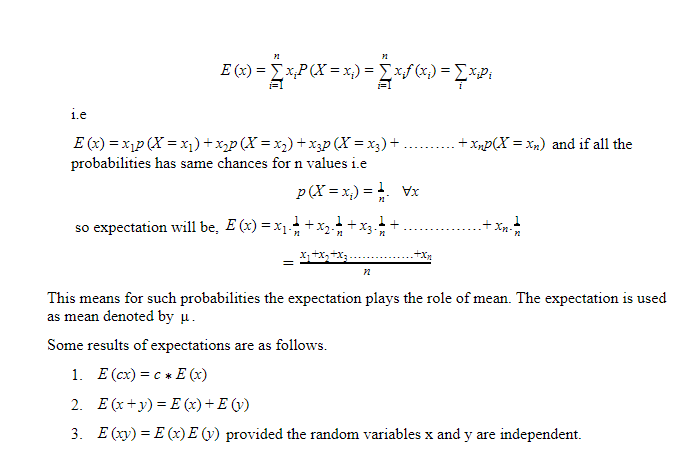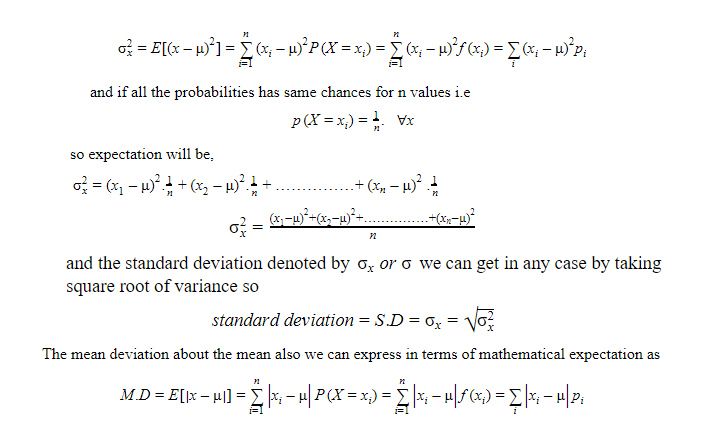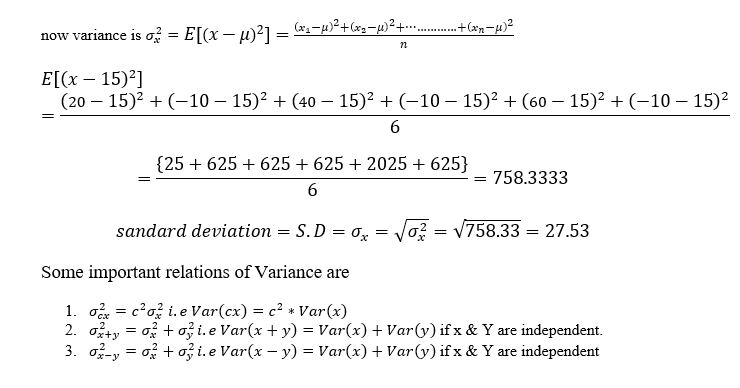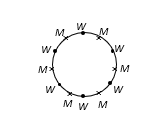Binomial & Poisson random variable and its properties
The random variable which deals with the success and failure outcome of the random experiment for n repetitions were known to be Binomial random variable the definition of its probability mass function deals with the probability of success p and probability of failure q only, the definition with examples already we has seen, now with the understanding we see some of the properties of such discrete random variable,
Expectation and Variance of the binomial random variable
Expectation and Variance of binomial random variable with n repetition and p as probability of success are
E[X]= np
and Var(X) = np(1-p)
now consider for showing these two the expectation of random variable of power k by following the definition of probability mass function for binomial random variable as,

where Y is another binomial random variable with n-1 trials and p as the probability of success, If we take the value of k=1 then we will get
E[X]= np
and if we substitute k=2 we will get
E[X2] =npE[Y + 1]
=np[(n-1)p + 1]
so we will get easily
Var(X)=E[X2] – (E[X])2
=np[(n-1)p + 1] -(np)2
=np(1-p)
Example: For an unbiased coin do the experiment of tossing 100 times and for the number of tails that appearing in this case find the mean, variance and standard deviation of such experiment.
The tail for one toss has the probability of success p=1/2=0.5
so the mean of such experiment is
E[X]= np
since the experiment is binomial as only success or failure we will get for n number of repetitions
so as μ=np
μ=100x(0.5)=50
Similarly the variance and the standard deviation will be
Var(X)= np(1-p)
σ2= np(1-p)

The value would be
σ2 =(100)(0.5)(0.5)=25
Example: Find the mean and standard deviation for the probability of 0.1 defectiveness in bolt manufacturing company from the lot of 400 bolt.
here n=400, p=0.1, mean= np =400×0.1=40
since
σ2= np(1-p)

so standard deviation will be

Example: Find the probability of exactly, less than and at least 2 successes if the mean and standard deviation for the binomial random variable is 4 and 2 respectively.
Since mean = np= 4
and variance = np(1-p) = 2,
so 4(1-p)=2
(1-p)=1/2
p=1-(1/2)
putting this value in mean we get
np = 4
n(1/2)=4
n=8
probability of exactly 2 successes will be

probability of less than 2 successes will be
p(X < 2)
=P(0) +P(1) = 8C0 p0q8 + 8C1 p1q7
=(1/256)+8 x (1/2) x (1/2)7 = 9/256
Probability of at least 2 successes
p(X>2)= 1- p(X<2)
=1-P(0) – P(1)= 1-[P(0) + P(1)] =1- (9/256)=247/256
Poisson Random Variable
The discrete random variable X that takes the values 0,1,2…….. is known to be Poisson Random variable provided for any λ>0 its probability mass function must be

or

as

When n is very large and the probability of success p is very small in such case Poisson random variable with its probability mass function became the approximation of binomial random variate with respective p.m.f. because the expectation in this case which is np will be moderate and that would be λ= np .
Example: Find the probability that there is at least one typing error on each page of the book which has Poisson distribution with mean 1/2 for a single page.
Let the discrete random variable X denote the errors on the page. so the Poisson random variable has the probability mass function as

λ = 1/2


Example: Find the probability that the sample of 10 items produced by a machine with 0.1 chances of defective production has at the most one defective item.

This we can solve both by binomial probability mass function as well as Poisson probability mass function, so we solve this by Poisson
Expectation and variance of the Poisson random variable
Expectation and Variance of Poisson random variable with n repetition and p as probability of success are
E[X]= np= λ
and
Var(X) = np= λ
Before showing the result the we must keep in mind that the Poisson random variable is nothing but the approximation of Binomial random variable so np= λ now expectation by using the probability mass function will be




This means the mathematical expected value of Poisson random variable is equal to its parameter, similarly for calculating the variance and standard deviation of Poisson random variable we require expectation of square of X so,




The above summation is obvious as two of the sums are expectation and sum of the probabilities.
Thus the value of variance we will get is
Var(X) = E[X2] – (E[X])2
=λ
so in the case of Poisson random variable the mean and variance have the same value i.e np as a parameter.
The Poisson random variable is the approximation good for the finding of diverse processes e.g. finding the occurrence of number of earthquakes within some specific time duration, finding the number of electron during a fixed time from the heated cathode, finding the possible number of deaths during specified time, or number of wars within specific year e.t.c.
Example : Calculate the probability that the total number of passengers in two days is less than 2. If the number of arrival of passengers with mean 5 follows Poisson random variable. mean=np=5
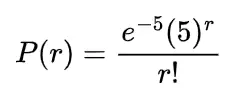
If we consider the number of passengers in two days less than 2 it would be
| First day | Second day | In total |
| 0 | 0 | 0 |
| 0 | 1 | 1 |
| 1 | 0 | 1 |
so the probability will be the combination of these two days as



=e-10[1+5+5]
=11e-10
=114.5410-5
=4.994*10-4
Example: Calculate the probability of 4 or more faulty condensers from a pack of 100 condensers provided the manufacturing defect for the condensers is 1%.
Here p=1% =0.01 and n= 100 * 0.01 =1
so we can use the Poisson random variables probability mass function P.M.F
mean= np = 100*0.01=1

so the probability for 4 or more faulty condensers will be

=1-[P(0)+P(1)+P(2)+P(3)]

Example: If 0.002 chances are there for a product to be defective from the manufacturing, for a pack containing 10 of such products what would be the probability that such a packet has no defective, one defective, and two defective products from the consignment of 50000 packets of same product.
Here for a single pack probability of defect i.e p=0.002, n=10
then the mean np=0.002*10= 0.020

we will find for each case as

So from the table it is clear that the number of defective blades in packets zero, one and two will be 4900,980,10 respectively.
Conclusion:
In this article we discussed some properties of one of Binomial random variable, Poisson random variable and Random Experiment. Also one more discrete random variable i.e Poisson random variable, discussed with properties. The distribution for the probability mass function, expectation , variance and standard deviation example also taken for better understanding , In the next articles we try to cover some more discrete random variables if you want further reading then go through Mathematics Page.
Schaum’s Outlines of Probability and Statistics

















